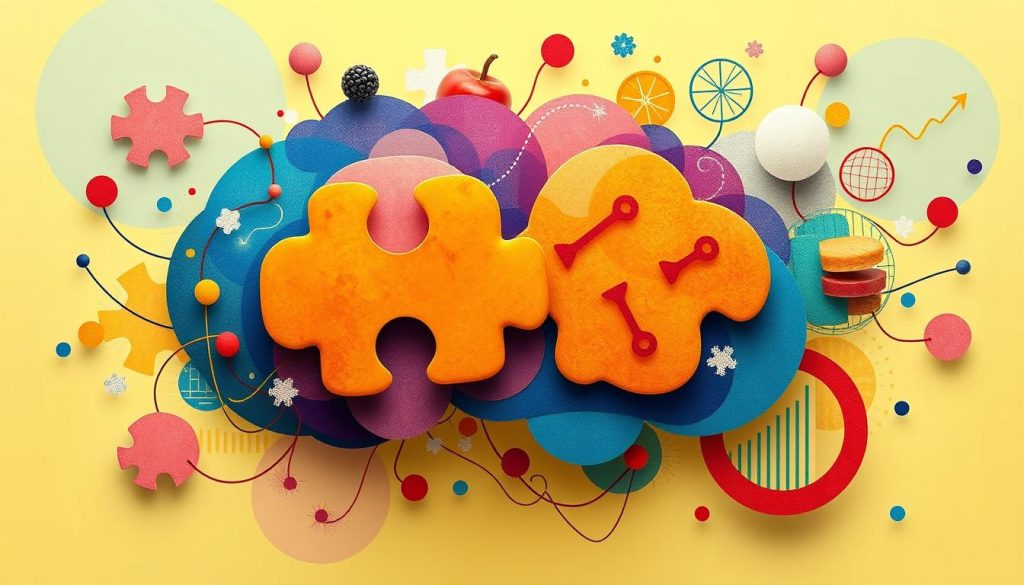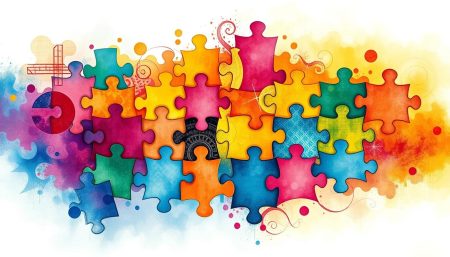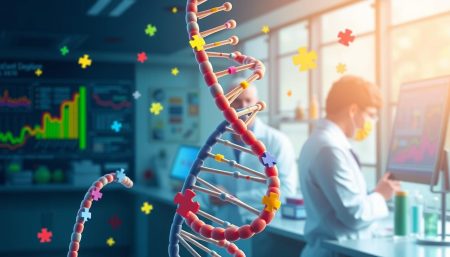Exploring the human mind and body, we find eating disorders autism spectrum and co-occurring autism and eating disorders at the center of medical talks. This guide aims to understand the complex link between autism spectrum disorder and disordered eating. It sheds light on the challenges in diagnosing and managing these conditions.
Grasping this dual issue means looking at symptoms and treatments deeply. It also means learning about the lives of those affected. By filling knowledge gaps and exploring care strategies, we aim to help those on the journey through eating disorders autism spectrum. Our goal is to improve their well-being and quality of life.
This article will dive deeper into autism spectrum disorder and disordered eating. We’ll look at behavioral patterns, prevalence, symptoms, and common eating disorders. With data and patient stories, we offer a wealth of information for those seeking answers or facing these challenges.
The Intersection of Autism and Eating Disorders
The relationship between autism and eating disorders is complex. It affects social, emotional, and physical health. These conditions often happen together, showing a deep comorbidity that needs careful attention and specialized care.
Sensory sensitivities in autism can affect what someone eats. This might lead to eating too little, like in anorexia or ARFID. The connection between autism and eating disorders is strong because of shared behaviors and psychological traits. This makes it key to treat and support these individuals in a thoughtful way.
- Autism’s focus on routines can be similar to anorexia’s need for control.
- Autism’s sensory aversion can cause selective eating, like in restrictive eating disorders.
- Challenges with emotional regulation in autism can make stress-eating worse, seen in bulimia.
The relationship between autism and eating disorders is not just a coincidence. It involves a complex mix of shared traits and challenges. This makes diagnosis and treatment harder. It’s important to see each person as a whole.
| Condition | Common Overlapping Characteristics | Impact on Individual |
|---|---|---|
| Autism | Preference for sameness, sensory sensitivity | Challenges with change, peculiar eating habits |
| Eating Disorders | Need for control, obsessive behaviors | Nutritional deficiencies, increased anxiety around eating |
It’s vital to understand the comorbidity between autism and eating disorders. Treatment plans must take into account the complex nature of these conditions. This helps improve mental and physical health for those affected. Tailored treatments and support can greatly enhance the quality of life for these individuals.
Eating Disorders Autism Spectrum: Understanding the Link
Looking into the autism spectrum in eating disorders shows us special challenges and key insights for better management. People on the autism spectrum have unique ways of thinking and feeling that affect how they eat. This means we need to tailor treatments for them, taking into account their neurodiversity and personal needs.
At the heart of this connection is the impact of sensory sensitivities. Many on the autism spectrum find certain foods too overwhelming. This can lead to eating only a few foods, which might turn into a serious eating disorder. Also, their love for routine can make changing their eating habits very hard.
- The need for structured interventions that also allow for flexibility.
- Understanding and using dietary plans that fit their sensory needs.
- Creating nutritional plans that are both healthy and appealing to their senses.
Good treatment for eating disorders in autism requires a team effort. It involves diet planning, behavior therapy, and making changes in their environment. This all-around approach helps manage the eating disorder and improves their overall health, while respecting their neurodiversity.
| Cognitive Aspect | Impact on Eating Behavior | Treatment Focus |
|---|---|---|
| Need for Sameness | Rigid dietary patterns | Introduce variety systematically |
| Sensory Sensitivity | Aversion to certain textures/flavors | Customizable meal plans |
| Communication Difficulties | Challenges in expressing dietary preferences or discomforts | Enhanced communication strategies |
Autism Spectrum in Eating Disorders: Clinical Profile
Looking into autism and eating disorders shows unique challenges. It’s hard to match the autism diagnostic criteria with eating behaviors. Knowing these patterns helps create better treatments for both ASD and eating disorders.
Core Symptoms and Diagnostic Challenges
Diagnosing autism with an eating disorder is tricky. The autism criteria include social communication issues, repetitive behaviors, and sensory sensitivities. These can mix with eating disorder symptoms, making diagnosis and treatment hard.
Sensory processing in autism affects how people see and feel sensory information. This can change food choices and eating habits. It leads to issues like only eating certain foods.
Behavioral Characteristics of ASD in Eating Patterns
People with autism might have special eating habits. They might stick to certain foods and avoid others because of sensory issues. This can be confused with disordered eating by those who don’t know about autism’s sensory effects.
It’s important to understand the difference between autism-related food choices and eating disorders. This helps in treating the right issue.
- Enhanced focus on sensory-friendly foods to accommodate texture preferences.
- Integration of structured eating schedules into daily routines to provide predictability.
- Therapeutic interventions aimed at gradually introducing new foods in a non-threatening manner.
Using a team approach can help tackle eating challenges in autism. It can also lower the chance of eating disorders.
Co-occurring Autism and Eating Disorders: Prevalence and Statistics
Autism spectrum disorders (ASD) and eating disorders often go hand in hand, bringing unique challenges. It’s important to understand how common these conditions are together. This knowledge helps us create better support and treatments.
Recent Studies and Findings
Recent studies in top medical journals show more people with autism also have eating disorders. This means eating disorders are more common in those with autism than in others. It highlights the need for specific treatments and care plans.
Demographic Variations in Co-occurrence Rates
How common autism and eating disorders are together can vary. This depends on factors like age, gender, and social status. These factors affect how these conditions are diagnosed and treated. Let’s look at how these factors influence the rates of ASD and eating disorders.
| Age Group | ASD Prevalence (%) | Eating Disorder Prevalence (%) | Co-occurrence (%) |
|---|---|---|---|
| Children (0-12 years) | 1.5 | 0.3 | 0.2 |
| Adolescents (13-18 years) | 2.3 | 3.1 | 1.5 |
| Adults (19+ years) | 1.8 | 2.3 | 1.2 |
This table shows how age affects the rates of these conditions. It helps us plan better interventions.

Eating Disorder Symptoms in Autism: What to Watch For
It’s key to know how eating disorder symptoms show up in people with autism. They might look different because of sensory issues and how they communicate. This makes spotting eating disorders in autism tricky.
Here’s a list of signs of eating disorders that are important for the autism community. It’s vital for those caring for them to monitor eating habits closely. This way, they can catch these signs early.
- Limited variety of preferred foods, which could be more rigid than typical dietary preferences seen in autism
- Sudden refusal of foods previously accepted or liked, without obvious reasons
- Increased levels of distress related to meal times
- Behavioral signs of anxiety or distress during or about food
- Persistent concerns or discussions about weight even in the absence of actual overweight conditions
- Use of food rituals or eating patterns that may disrupt normal social eating situations
Spotting these signs of eating disorders early is very important. Early action can really help. Families and healthcare teams should keep a close eye on monitoring eating habits. This ensures they can act fast and help the person.
| Symptom | Details | Impact on Individual |
|---|---|---|
| Extreme Food Selectivity | Rejection of large groups of foods, not based on sensory characteristics | May lead to nutritional deficiencies |
| Distress at Mealtime | Expressions of stress or anxiety when presented with food | Can result in aversion to eating with others or in social settings |
| Irregular Eating Patterns | Eating at unusual times or excessive fasting | Potential development of serious eating disorders like anorexia or bulimia |
| Excessive Concern with Body Image | May verbalize unwarranted fears of being overweight | Could signal onset of body dysmorphic disorders |
Common Eating Disorders Among Individuals on the Autism Spectrum
Looking into how autism and eating disorders connect reveals two big challenges: restrictive eating in autism and binge-eating and autism. People with autism face a higher risk of these eating problems. These issues often show up together, making it hard to diagnose and treat them.
Anorexia Nervosa and Autism
Restrictive eating can turn into anorexia nervosa in some cases. This is when someone wants to lose weight a lot and eats very little. The strict habits of ASD can make it hard to eat different foods and follow nutritional advice.
Bulimia Nervosa and ASD: A Closer Look
Binge-eating and autism are also closely tied, with bulimia nervosa being a concern for some. The cycle of binge-eating and purging is tough in autism. This is because controlling emotions and impulses can be hard.
To learn more about autism and its connection to other mental and behavioral issues, check out understanding autism.
| Eating Disorder | Common in Autism | Key Challenges |
|---|---|---|
| Anorexia Nervosa | High | Rigidity in diet, weight obsession |
| Bulimia Nervosa | Moderate | Impulse control, emotional dysregulation |
Treatment Options for Eating Disorders in Autism
Creating treatment plans for those with Autism Spectrum Disorder (ASD) and eating disorders is key. These plans must be tailored to each person’s needs. This is because ASD brings its own set of challenges that need special care.
Integrating Autism Support with Eating Disorder Therapies
Effective therapy for ASD and eating disorders requires a team effort. Experts in psychology, nutrition, and behavior work together. This team approach helps find the best way to treat the disorders.
It’s not just about treating symptoms. It’s about understanding and addressing the underlying causes. This makes the treatment more effective.
Customizing Treatment Plans for the Spectrum
Personalized healthcare is essential for treating ASD and eating disorders. Each plan must fit the individual’s unique needs and behaviors. This approach helps patients stay engaged and improves their health outcomes.
These plans might include cognitive behavioral therapy, nutritional counseling, and medication. The goal is for these elements to work together seamlessly. Healthcare facilities that focus on personalized healthcare can adjust these plans as needed.
The aim of these treatments is to provide care that goes beyond the clinic. It helps individuals thrive in their daily lives and enhances their overall well-being.
The Importance of Early Identification of Eating Disorders in Autism
Spotting eating disorders early in people with autism is key to better health and happiness. Proactive screening and early intervention strategies help a lot. They lead to better treatment and a brighter future.
Eating disorder identification in individuals with autism is a detailed task. It needs a deep grasp of both conditions. Autistic people might have special food likes and be very sensitive to tastes and smells. This makes finding and treating eating disorders harder.

- Proactive screening means looking for eating disorder signs during regular check-ups.
- Creating early intervention strategies for autism ensures they work well for each person.
Starting these steps early can really help. It can make symptoms less severe and improve treatment chances. Early detection means we can tailor help just right, at a time that really matters.
After finding and starting treatment, keeping an eye on things and adjusting plans is vital. This is because people with autism grow and their needs change. It takes teamwork from mental health pros, nutritionists, and caregivers. They need to know how to help at the crossroads of autism and eating disorders.
Relationship Between Autism and Eating Disorders: A Deep Dive
Exploring the link between autism and eating disorders is complex. It involves looking at the causes of both conditions. This helps us understand how genetics and environment play a role.
Potential Genetic and Environmental Factors
Research shows that genetics might link autism and eating disorders. Studies find common genetic markers in both. Environmental factors like toxins or poor nutrition also matter.
Psychological Aspects of Co-occurring Conditions
Psychosocial factors are key in eating disorders for those with autism. Challenges in social interaction, sensory sensitivities, and the need for routine affect eating. It’s vital to understand these to help this group.
Nutritional Management within Autism Spectrum Disorder and Disordered Eating
Dealing with Autism Spectrum Disorder (ASD) and eating issues, nutritional therapy is key. It helps improve health outcomes for both mind and body. It’s important to make nutrition plans that fit each person’s needs, as everyone with ASD is different.
Starting dietary interventions for ASD means checking for nutritional gaps and creating a balanced diet. This therapy not only helps with ASD symptoms but also with eating disorders. A team of dietitians, therapists, and doctors is needed to make these plans work.
- Working with healthcare experts to make diets that fit sensory needs and avoid nutritional gaps.
- Keeping an eye on and changing diets as needed based on how well they’re working.
- Teaching families about nutrition to help keep healthy eating habits going at home.
Here’s how food choices can help manage ASD and eating problems:
| Nutrient | Benefits | Sources |
|---|---|---|
| Omega-3 Fatty Acids | Helps with thinking and brain growth | Fish, chia seeds, flaxseeds |
| Protein | Helps with growth and fixing the body | Lean meats, legumes, tofu |
| Calcium | Important for strong bones | Milk, fortified almond milk, kale |
| Fiber | Good for the digestive system | Whole grains, vegetables, fruits |
Adding nutritional therapy to ASD care means always checking and changing diets as needed. By focusing on lasting dietary interventions for ASD, we can greatly improve health outcomes. This helps ASD individuals live happy, healthy lives.
Family Dynamics and Its Role in Autism Related Eating Disorders
Understanding family dynamics is key to tackling autism-related eating disorders. The right mix of family involvement in treatment, caregiver support, and stress management can greatly help. This can lead to better outcomes for those affected.
Support Systems and Their Effectiveness
Strong support systems are essential for families dealing with autism and eating disorders. They offer emotional support and the tools needed to manage the situation. Working with healthcare professionals and joining support groups can greatly improve caregiver support.
Coping Mechanisms for Families and Caregivers
It’s vital to have good coping strategies for managing family stress. These can include family therapy, educational programs, and activities that reduce stress. Including family involvement in treatment plans can create a more supportive environment. This helps reduce the stress on caregivers and other family members.
| Coping Strategy | Description | Impact on Family Stress |
|---|---|---|
| Family Therapy | Tailored sessions with all family members, facilitated by specialized therapists. | Reduces tension and improves communication within the family unit. |
| Educational Programs | Programs designed to educate families about autism and associated eating disorders. | Increases understanding and equips families with necessary skills to manage conditions. |
| Recreational Therapy | Therapeutic activities aimed at relieving stress and improving mental health. | Promotes relaxation and strengthens familial bonds. |
Using these structured methods can improve treatment outcomes and ease family stress. It makes a big difference in managing autism and eating disorders.
Barriers to Proper Diagnosis and Treatment in Co-occurring Autism and Eating Disorders
Diagnosing and treating autism and eating disorders together is tough. Challenges in healthcare make it hard. It’s key for doctors to learn more to help patients better.
Stigmas and Misconceptions Complicating Treatment
Stigma around autism and eating disorders can stop people from getting help. Misbeliefs like “autism doesn’t affect body image” or “eating disorders are a choice” make treatment hard. It’s important to teach everyone about these conditions to help patients.
The Role of Healthcare Professionals
Doctors are key in treating these conditions. They learn more through professional education. Knowing more about these cases helps them treat patients better.
| Challenges | Strategies for Overcoming | Benefits of Improved Diagnosis |
|---|---|---|
| Limited specialized training | Enhancing educational programs in medical schools | Higher accuracy in diagnoses |
| Stigma and bias | Community outreach and professional workshops | Increased trust and community support |
| Misconceptions about co-occurrence | Ongoing professional development for healthcare providers | More effective, personalized treatment plans |
Fostering Social Support Networks for Individuals with Autism and Eating Disorder Prevalence
The importance of peer support, social inclusion, and community resources for those with autism and eating disorders is huge. These elements help create a supportive environment. This environment is key for better health and happiness.
Creating social support networks is vital for these individuals. Peer support groups, online or in person, offer a space to share and learn. They help reduce feelings of loneliness.
- Social inclusion efforts in schools and communities help people with autism connect. This boosts their social skills and interactions.
- Access to community resources like therapy and special programs can greatly improve their lives.
Getting people to these services often requires teamwork. This includes healthcare, education, and community groups working together.
Let’s compare the effects of strong social support versus little support for those with autism and eating disorders:
| Aspect | With Strong Social Support | With Limited Support |
|---|---|---|
| Mental Health | Improved stability, reduced mental stress episodes | Higher risk of depression and anxiety |
| Social Skills | Improved social interactions | Poor social skills and isolation |
| Management of Eating Disorder | More effective coping | Worse eating disorder symptoms |
| Overall Well-being | Higher quality of life and happiness | Lower life satisfaction |
It’s clear that strong peer support and social inclusion with access to community resources help a lot. They lessen the bad effects of having autism and eating disorders together.
Advances in Research: Autism and Eating Disorder Identification and Care
The healthcare world is changing fast, thanks to innovation in treatment and care. This is true for autism (ASD) and eating disorders. Recent developments in ASD care have led to new ways to diagnose and support better. Research is helping us understand and manage the link between ASD and eating disorders.
Cutting-edge research is giving doctors new tools to diagnose and treat. Teams are using technology, genetics, and brain science to tackle complex issues. This means doctors can spot problems sooner and help people more effectively.
There’s a lot to be hopeful about in the future of research. It’s going to help us learn more about the needs of people with autism and eating disorders. The medical field is always getting better, and we’re excited to see what’s next for these vulnerable groups.
FAQ
Q: What is the connection between eating disorders and the autism spectrum?
A: Eating disorders and autism spectrum disorder (ASD) are linked in complex ways. People with ASD might face a higher risk of eating disorders. This is due to traits like rigid habits and sensory sensitivities.
They also struggle with social communication and managing emotions. These challenges can affect their eating habits.
Q: How prevalent is the co-occurrence of autism and eating disorders?
A: Studies show that eating disorders are more common in people with autism. This is true for disorders like food selectivity and ritualistic eating. These behaviors are often seen in those with ASD.
Q: Are there specific eating disorders that are more common in individuals on the autism spectrum?
A: Yes, anorexia nervosa and avoidant/restrictive food intake disorder (ARFID) are more common in ASD individuals. These disorders involve restrictive eating. This fits with the autistic preference for sameness and routine.
Q: How are eating disorders diagnosed in individuals with autism?
A: Diagnosing eating disorders in autism is tough. Symptoms can overlap, and communication is different. A detailed evaluation by experts in both ASD and eating disorders is key.
They look at eating patterns, weight changes, and psychosocial factors. This helps get an accurate diagnosis.
Q: What treatment options are available for individuals with co-occurring autism and eating disorders?
A: Treatment for autism and eating disorders together includes nutrition plans, psychological therapies, and ASD-specific interventions. A team approach is best for effective care.
Q: Why is early identification of eating disorders important in autism?
A: Early spotting of eating disorders in autism is vital. Early help leads to better outcomes and less risk of serious health issues. Caregivers and professionals should watch eating behaviors closely.
Q: What are some barriers to proper diagnosis and treatment in co-occurring autism and eating disorders?
A: Barriers include not recognizing both conditions, myths about autism and eating disorders, and a lack of trained professionals. More awareness and education are needed among healthcare workers.
Q: How can family dynamics impact eating disorders in individuals with autism?
A: Family dynamics greatly affect eating disorders in autism. Supportive families help with better eating habits and treatment. Stress and misunderstandings can worsen symptoms, though.
Q: How can nutritional management be tailored to individuals on the autism spectrum with disordered eating?
A: Nutritional plans for autism and eating disorders should consider sensory likes and dislikes, routine needs, and communication issues. Dietitians with autism and eating disorder experience are essential for personalized plans.
Q: What role do social support networks play in the treatment of autism and eating disorder prevalence?
A: Social support networks are critical for treatment. They offer emotional support, reduce loneliness, and improve mental health. Inclusive environments and friendships help in coping and treatment engagement.


















